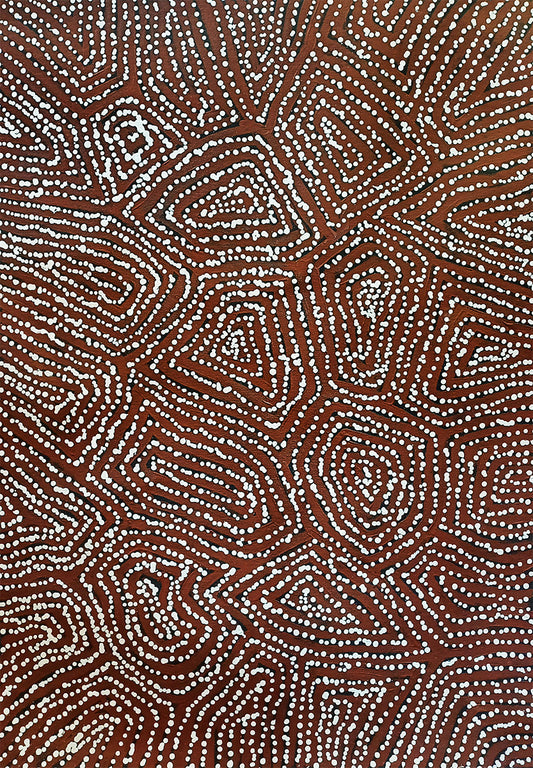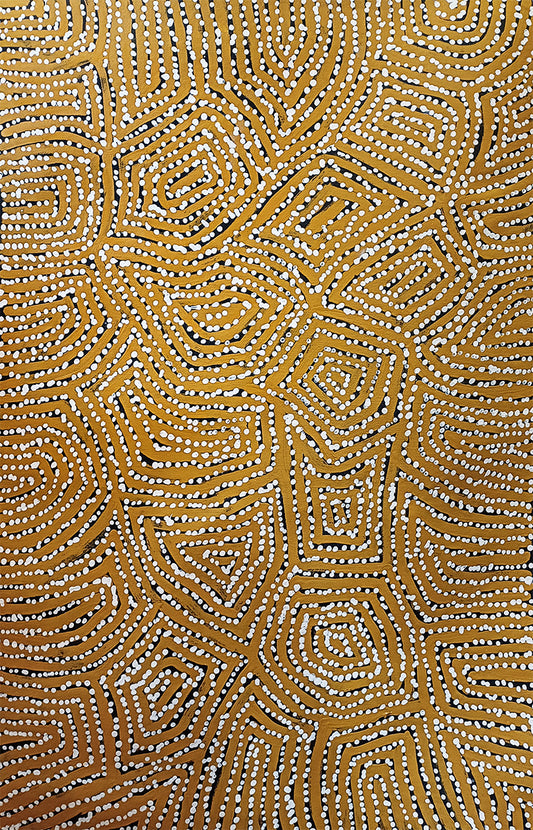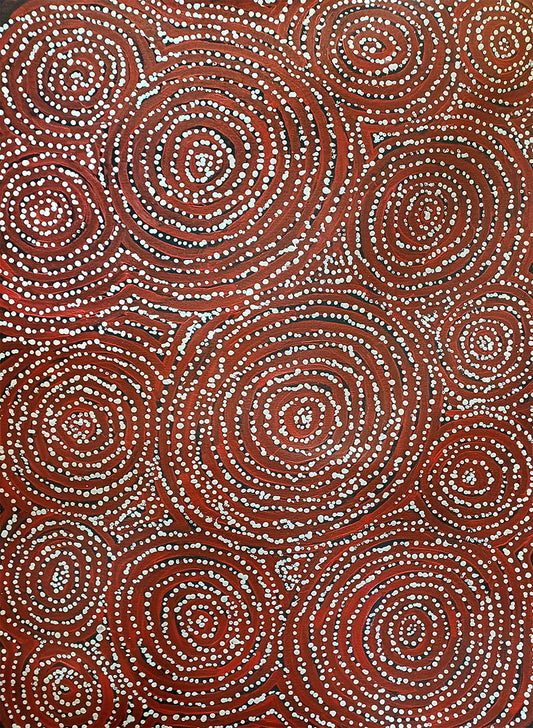Collection: George Ward Tjungurrayi
DOB: c.1945-2023 Kiwirrkurrra WA
Community: Warakurna
Language: Pintupi

George Ward Tjungurrayi was born in Kiwirrkura around the year 1945. George and his older brother, Willy Tjungurrayi, who is also a senior Pintupi painter, moved to Papunya in the 1960s. He was brought into Papunya in 1962 by the Northern Territory patrols which Jeremy Long was in charge of after watching local artists painting at that time.
In 1984 George Ward first painted on canvas: a handful of elegantly “classical” concentric roundel works from that time survive. After the death of his brother, Yala Yala in 1998, the responsibility to paint fell squarely on Ward’s shoulders. By this stage, he was a senior desert man: He lived deep in the world of law. He began to paint in earnest, developing his own distinct style. The canvases he began producing for Alice Springs-based Papunya Tula artists were like nothing else that had come before in the desert art movement: sombre, cerebral, full of grave intellect.
The big lake site of Kaakuratintja (Lake Macdonald), which a large group of Tingari men travelled through on their way east, is often the subject of his paintings. His meticulous geometric drawing is often offset by more rapid, shaking dotting to produce a shimmering surface. In 2004 George won the prestigious 2004 Wynne Prize at the Art Gallery of New South Wales. George has also exhibited in many galleries throughout the past decade.
George Ward is a reticent and silent Western Desert man. These character traits can cause the odd practical problem, now that he has become one of the nation’s most admired and most keenly collected artists. He’s not at home in English; sees no merit in photographs; is uneasy in big, bustling towns like Alice Springs. “I’m a bush man, me,” he insists, with a distinct, proud edge in his voice.
George began painting for the Papunya Tula Artists in 1976, at the West Camp of Papunya where the nomadic desert people stayed and at various locations, including Mt Liebig (Yamunturrngu) and Kintore (Walungurru), and the Yayayi and Waruwiya outstations, working alongside Joseph Jurra Tjapatjarri and Ray James Tjangala.
His paintings are striking Tingari stories, done in linear optical stripes and square patterns. The depictions and designs in his works have brought him into prominence and are now highly sought after by collectors and galleries worldwide. George currently lives at Wallangarra (Kintore), Northern Territory. He is brother to Natta Nungurrayi. His son is Jake James Tjapaltjarri also a collectible artist.
George’s father died while he was still very young. It was only in his teenage years that he first encountered Europeans, when a commonwealth welfare patrol came upon his family group camped by a desert waterhole. After travelling to the government settlement at Papunya, first home of the desert painting movement, Ward worked briefly as a fencer and a butcher in the community kitchen. He also met and married his wife, the somewhat formidable Nangawarra, a member of one of the desert’s most dominant families.
George Ward Tjungurrayi passed away on the 22nd of September 2023 surrounded by his wife, daughter and family.
Auction Results:
Highest Auction Price – $42,000
59 works have sold at auction since 2004
Awards:
2004 – Wynne Prize – NSW Art Gallery
Collections:
National Gallery of Victoria – purchased
1997 ArtbankArt Gallery of South Australia, Adelaide Groninger Museum, Groningen Museum of Victoria, Melbourne, Robert Holmes Court Collection, Perth Supreme Court of the Northern Territory, Darwin
Selected Solo Exhibitions:
1997 – Utopia Art, Sydney – Solo show
1998 – Gallery Gabrielle Pizzi, Melbourne, Australia
Selected Group Exhibitions:
1990 – Friendly Country – Friendly People, Araluen Centre for the Arts, Alice Springs, Australia
1991 – Araluen Centre for the Arts, Alice Springs, Australia
1992 – Broadbeach, Australia
1993 – Canberra, Australia
1994 – Broadbeach and Adelaide, Australia
1995 – Canberra, Australia’Dreamings’ – Tjukurrpa, Groninger Museum, Groningen,The Netherlands Museum & Art Gallery of the Northern Territory, Darwin Papunya Tula Artists Pty. Ltd., Alice Springs Australia Utopia Art Sydney, Australia
1996 Adelaide Fringe Festival, Papunya Tula Artists Pty. Ltd., Adelaide Araluen Centre for the Arts, Alice Springs Gallery Gabrielle Pizzi, Melbourne Museum & Art Gallery of the Northern Territory, Darwin Nangara. The Australian Aboriginal Art Exhibition, Brugge, Belgium Papunya Tula Artists Pty. Ltd., Alice Springs
1997 – Gallery Gabrielle Pizzi, Melbourne Geschichtenbilder, Aboriginal Art Galerie Bhr, Speyer, Germany Papunya Tula Artists, Alice Springs, Australia
1998 – The Desert Mob Show, Araluen Centre for the Arts, Alice Springs, Australian
1999 – Aboriginal Art, IHK Wrzburg, Deutschland (in Kooperation mit Aboriginal Art Galerie Bhr, Speyer)
2000 – ‘Art of the Aborigines’, Leverkusen, Germany (in cooperation with Aboriginal Art Gallery Bahr, Speyer)’Lines’, Brisbane, QueenslandPapunya Tula: Genesis and Genius, Art Gallery of New South Wales, Sydne Pintupi Men. Papunya Tula Artists, Alice Springs, NT, Australia
2001 – Art of the Pintupi, AdelaideKintore and Kiwirrkura. Gallery Gabrielle Pizzi, MelbournePalm Beach Art Fair, Palm Beach, Florida, USA Papunya Tula
2001 – Melbourne, Australia
2004 – Art Gallery of NSW- Wynne Prize
-
Aboriginal Painting - Tingari Cycle
Vendor:George Ward TjungurrayiRegular price $5,300.00 AUDRegular priceUnit price / per -
Aboriginal Painting - Tingari Cycle
Vendor:George Ward TjungurrayiRegular price $4,500.00 AUDRegular priceUnit price / per -
Aboriginal Painting - Tingari Cycle
Vendor:George Ward TjungurrayiRegular price $5,500.00 AUDRegular priceUnit price / per






